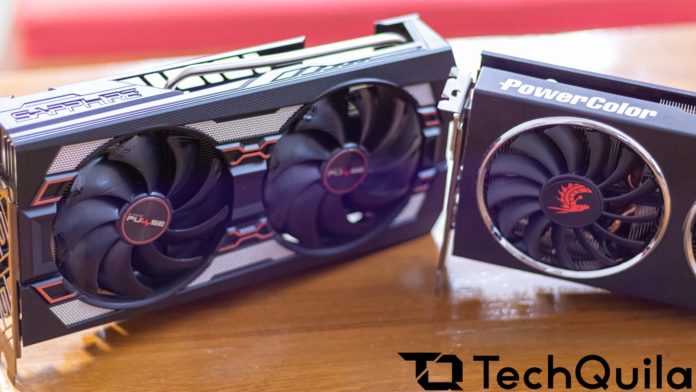
Earlier this year AMD unveiled the Radeon RX 5500 XT and 5600 XT, which were targeted towards the more budget-conscious gamers. We’ve reviewed both GPUs individually recently, but now it’s time to see which one provides the better value against each other.
Before that, make sure to check out our individual reviews. To be clear, we’re comparing the Powercolor RX 5500 XT against the Sapphire Pulse RX 5600 XT.
RX 5500 XT vs RX 5600 XT Specs
Let’s start off with the specs then. Both cards are tweaked from their reference design, so don’t go by AMD’s website just yet.
| RX 5500 XT | RX 5600 XT | |
| Compute Units | 22 | 36 |
| Cores/Stream Processors | 1408 | 2304 |
| Boost Frequency | 1845 MHz | 1750 MHz |
| Game Frequency | 1737 MHz | 1560 MHz |
| Memory | 8 GB | 6 GB |
| TDP | 130 W | 150 W |
| Price | ~ Rs. 18,000 | ~ Rs 30,000 |

You’ll notice here that the 5600 XT while having more compute units, is clocked slower than the 5500 XT. The memory configuration is also lower here, despite the fact that both cards are targeting 1080p for the most part. We went over the major difference in memory configuration between the mid-range RX 5000 cards here.
I still find it quite baffling that the lower end card has more VRAM, even though that will probably never get filled up. In case that the next-gen games really do take up much more memory with textures, then it’s equally odd that the faster card has a lesser amount of memory buffer. Oh well, time to move on from that.
Test Rig and Methodology
Alright, enough with the specs. It’s time to see how these cards actually perform when stacked against each other.
| CPU | Ryzen 7 3700X |
| RAM | 2x 8 GB G.SKill Tridentz RGB 3000 Mhz |
| Storage | Crucial P1 3D NAND NVMe PCIe M.2 |
| Power Supply | Corsair CX 550 W |
We tested both cards on the same system with the latest Radeon Software drivers. There were no game or driver updates in between, so rest assured that is the most direct comparison between the two.
RX 5500 XT vs 5600 XT – 1080p Gaming Benchmarks
We tested a variety of games in both DirectX 12 and the older DX11 API mode. These include popular older games like The Witcher 3 as well as newer titles like Red Dead Redemption 2 (which pushed both of these cards to the limit). We also threw in Remedy’s sleeper hit Control, which was notorious for bringing even the most powerful GPUs to their knees last year.

On average, we’re seeing a 34% increase in performance for a 66% increase in price (as per Indian prices). The RX 5600 XT’s performance increase here is as expected. You’re not getting less for what you’re paying for. When compared with the US prices, you’re getting the same 34% performance increase for a 50% price increase.
Moving on to DX11 vs DX12 titles, the performance was (as expected) better with the newer DirectX 12 API. The 5600 XT showed a better performance increase with the API when compared to the lower end Navi card.

The RX 5600 XT fulfills its promise of being a strong card for 1080p gamers, while its smaller brother sits in the corner.
Synthetic Benchmarks
Let’s go over some synthetic benchmarks now. I used 3D Mark Timespy as well as Furmark to test out the performance.

Again, the higher end Navi card outperforms the 5500 XT, as expected. The performance difference this time around is significantly larger though – 52% increase!

While we’ve proven how real in-game performance difference won’t be as huge, it’s something to take note of.
Conclusion
So there you have it. As you can see from the results, the Radeon RX 5600 XT wins as expected, but that wasn’t the point of comparing the two. What matters is whether the price difference makes sense in performance and whether you’re getting a comfortable gaming experience with the Navi cards.
The RX 5600 XT is quite surprisingly good, while the 5500 XT is just fine. If you’re living in the US then you’ll have to shelve outright about 50% more money for 34% performance increase, which doesn’t exactly sit right. The 5600 XT, when taken into consideration individually, is a really good card, especially with the RTX 2060 being priced about the same with slightly lower performance. We’re running into the same conclusion with the 5500 XT as we did in its review – it’s simply not better than the competition. You’re much better off paying lesser for the 4GB version of the card which offers better value.
All in all, I’m really looking forward to the RDNA 2 refresh that’ll come later in the year. The replacement for the 5500 and 5600 XT should come in about a year if AMD follows the current release strategy. I’m pretty sure those will provide much better value, especially with the lower end of the stack, as RDNA 2 promises much better efficiency.




